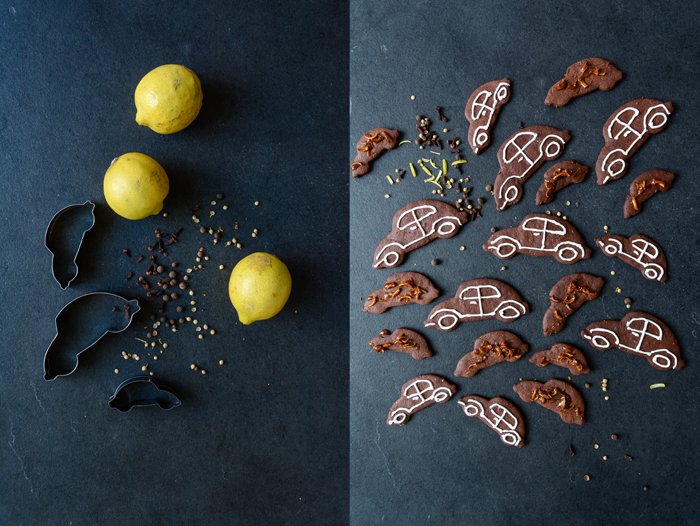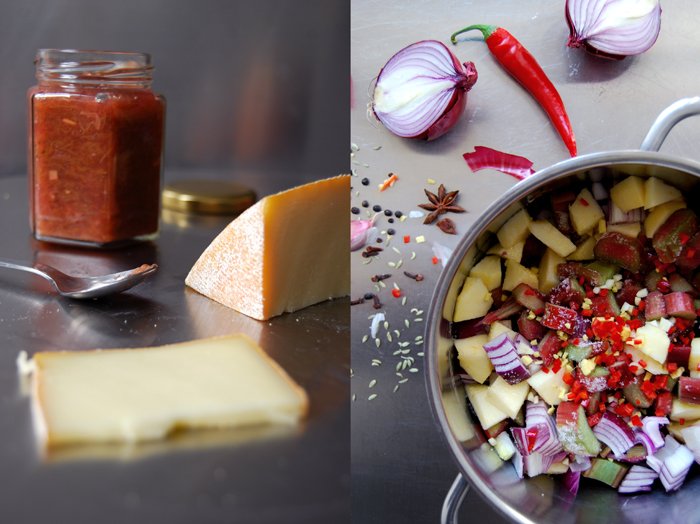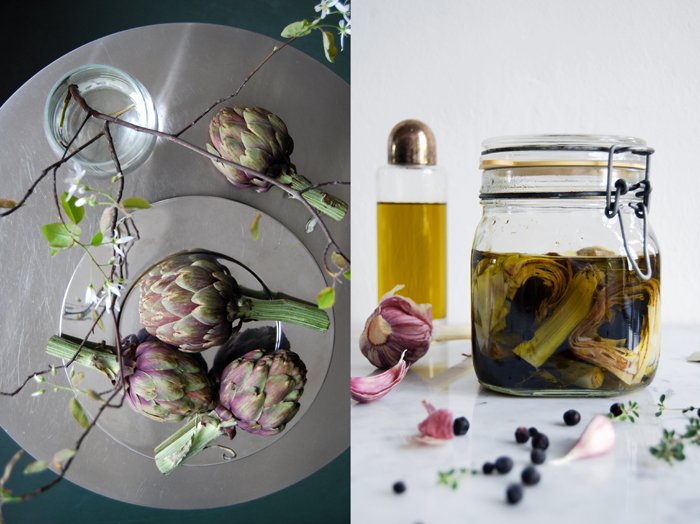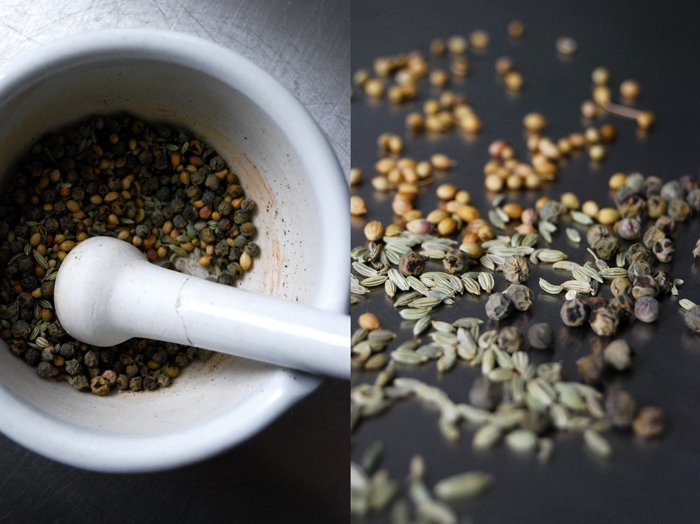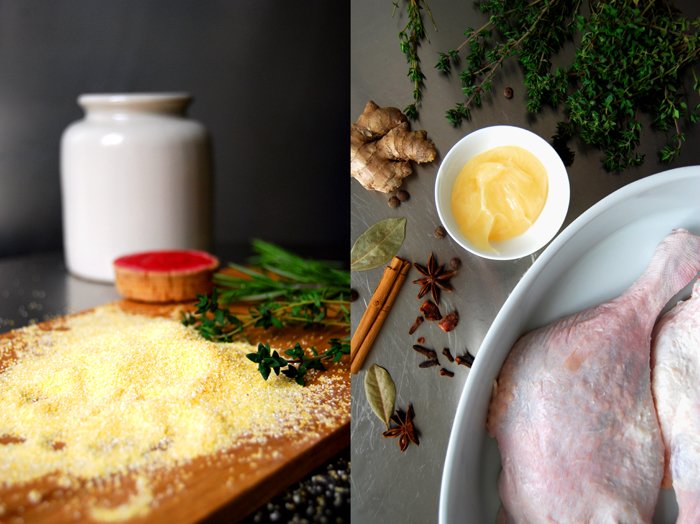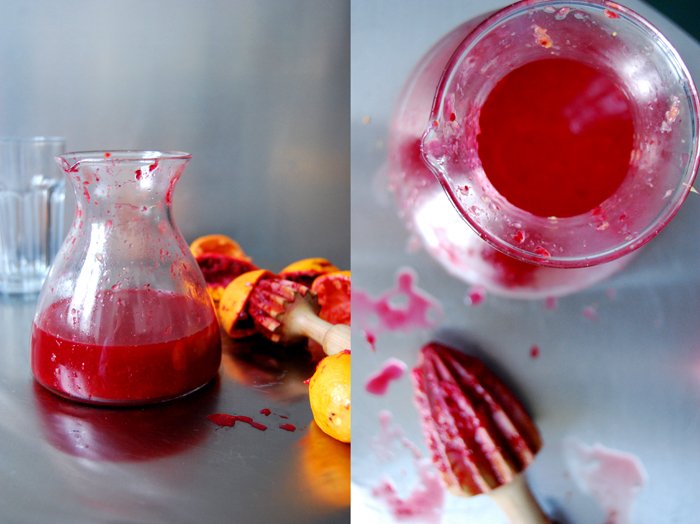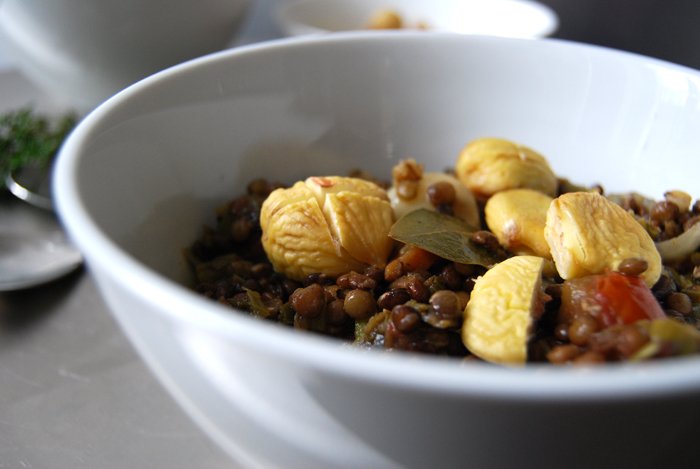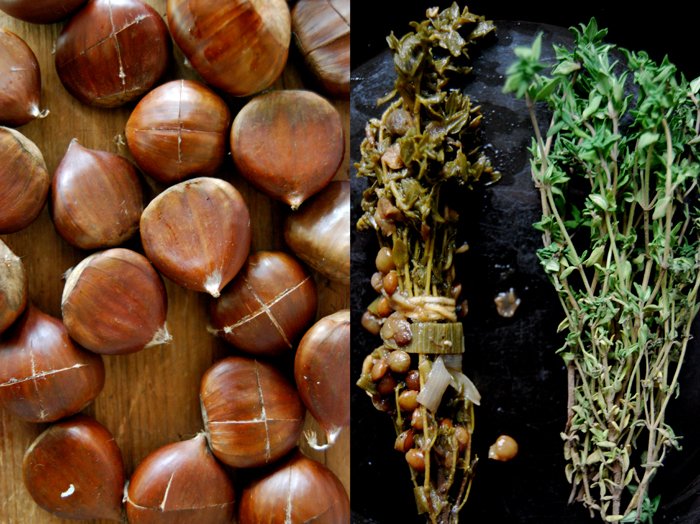23 Recipes for Cozy Christmas Baking
Berlin, December 2017:
I'm sitting at my dining table, listening to Jingle Bells, wrapping Christmas presents, and waiting for the snow to fall. It's the last weekend before Christmas, the last chance to fill the kitchen with the tempting smell of cinnamon, cloves, and citrus fruits, cardamom, chocolate, and candied nuts, so what am I going to bake? I picked 23 recipes from the last four years of cozy Christmas feasting on Eat In My Kitchen and I love each one of them. Just a look at the pictures and my taste buds get excited. I can remember the woody notes of my Rosemary and Lemon Heidesand Cookies, the citrusy-buttery sweetness of my Mediterranean family's Maltese Lemon Christmas Cookies, the elegance of my mother's classic, her Linzer Cookies, and of course, my annual highlight, the best Vanilla Kipferl in the world. You can find a variation of this famous German cookie in my Eat In My Kitchen book, wonderfully fragrant Cardamom Kipferl. So, happy baking, treat yourself to a cozy weekend with the ones you love and indulge in the pleasures of Christmas baking!
Click on the titles for the recipes:
Chocolate Spice Christmas Cookies with Candied Lemon Peel
I used to have a huge spice box in my kitchen that didn't look very pretty and also wasn't particularly practical. For whatever reason, I decided in my early kitchen years to store all my spice filled glass jars and tiny metal tins in this box and that's where I kept them for two decades. This beaten and buckled box still exists, I just use it for potatoes at the moment (even a box has to stay flexible in life). I used to arrange my spices in two layers of jars, so when I needed juniper berries from the bottom, I would always have to empty the whole thing. Rather impractical.
Around two years ago, I renovated my kitchen, I changed the sink and cupboards on one side of the room. When everything was set up, I had a skype call with my Maltese mama Jenny to proudly present my work to her. Not that she's particularly experienced in kitchen renovation, it's rather the opposite, she still works in her gorgeous sea-blue kitchen gem from the 60s. I don't remember why, but we started discussing the spice-situation in my kitchen. There's a slim cupboard with two sliding drawers next to my sink, so when we had our video chat, we both looked at this drawer and decided that it should become my spice cupboard. I arranged everything that same day and since then I'm more than happy to have such a luxurious overview of my spice collection.
The spices I use the most, right at the front when you open the door, are Maltese fennel and coriander seeds, the whole range of peppercorns in black, green, white, and pink, cinnamon, and cardamom. Jars of cumin, cloves, aniseed, allspice, juniper berries, and mustard seeds are right behind. Then there's the hot section, with cayenne and urfa chilli, plus sumac and a few spice mixtures. I love this cupboard, it's a bit chaotic, and it's still a colourful collection of various jars and containers, but it smells beautiful.
Although I generally prefer a certain order in my kitchen, there are zones and tools in this room that seem to follow their own rules. Cookie cutters, for example, tend to end up in places where I don't even know how they got there. I bought a large metal ring at one point to get my growing collection under control. Every year I buy a couple new ones to add to the classics, to stars, angels, and Santa. I tend to have annual favourites. Squirrel, sausage dog, and deer were popular for a long time, which might speak for my love of cute animals. My collection of three beetles is relatively new, maybe I need a car? Who knows. But apart from giving my cookies a cute look, a cutter should be practical. For example, I barely use the deer anymore because the cookies tend to lose their antlers in the oven, so it looks rather sad. My beetles however are very cooperative, roundish, no narrow parts, and they are even big enough to get a proper royal icing decoration.
I must admit that decorating sweets is not one of my best talents. But I thought it would be nice to bake some cookies at this time of year that you can decorate - especially if there are kids around the baking table. And if you're as lazy as I am and you have a soft spot for citrus, I have a great alternative for you. Decorate half the batch of these delicious chocolate spice cookies with royal icing (I recommend you trust the pros and buy the mixture from a baking shop) and make your children happy. For the other half, caramelize lemon peel until sweet and crunchy, sprinkle this sticky golden mixture over the remaining cookies and make yourself happy. These are the adult cookies. They aren't as pretty as the cute hand decorated ones, but the combination of dark chocolate, cinnamon, cloves, coriander, aniseed, and candied lemon peel makes up for it. They taste so unbelievably good that you won't even mind the looks.
For more delicious recipes and kitchen inspiration, visit Volkswagen's Pinterest community board Food Bloggers for Volkswagen.
Chocolate Spice Christmas Cookies with Candied Lemon Peel
Makes about 50 cookies
For the cookies
plain flour 260g / 2 cups
unsweetened cocoa powder 50g / 1/2 cup
baking powder 1/4 teaspoon
freshly grated lemon zest 1 tablespoon (from 1 large lemon)
ground cinnamon, 1 teaspoon
cloves, ground in a mortar, 10 (about 1/2 teaspoon ground cloves)
coriander seeds, ground in a mortar, 2 teaspoons
aniseed, ground in a mortar, 1/2 teaspoon
allspice berries, ground in a mortar, 4
fine sea salt 1/8 teaspoon
butter, at room temperature, 130g / 1/2 cup plus 1 teaspoon
icing sugar 120g / 1 1/4 cups
organic egg 1
For the decoration
(if decorating half the cookies with royal icing and the other half with candied lemon peel)
royal icing mixture, whisked with a little water, about 60g / 2ounces
granulated sugar 50g / 1/4 cup
water 2 tablespoons
very thin strips of fresh lemon peel, 1 small handful
In a large bowl, combine flour, cocoa powder, baking powder, lemon zest, cinnamon, cloves, coriander, aniseed, allspice, and salt.
In the bowl of a stand mixer, fitted with the paddle attachment, beat the butter and icing sugar until fluffy. Add the egg and mix for about 1 minute or until well combined. Replace the paddle attachment with the dough hook, add the flour-spice mixture to the bowl with the butter, and mix until well combined. Form a thick disc, wrap in cling film and put in the freezer for about 20 minutes.
Preheat the oven to 160°C (325°F) and line 3 baking sheets with parchment paper.
In batches, roll the dough out thinly (about 3mm / 1/8" thick) between cling film and cut out cookies in whatever shape you like. Keep the remaining dough in the fridge while cutting the cookies. Arrange the cookies on the lined baking sheets and bake, one baking sheet at a time, for about 6 minutes or until golden. Let them cool for a few minutes before you transfer them to a cooling rack.
For the royal icing, whisk the royal icing mixture with a little water (following the instructions on the package) and, using a piping bag with the smallest attachment you can find, decorate half the cookies.
For the candied peel, in a small saucepan, bring the sugar and water to the boil. When it starts to caramelize add the lemon peel. Lower the heat to medium and cook for about 3 to 4 minutes or until the peel is golden and soft—mind that it doesn't burn. While the caramel is still liquid (you can leave the saucepan on lowest heat), quickly sprinkle the remaining cookies with the candied lemon peel.
Happy baking!
Elisenlebkuchen - Juicy Spice Cookies with Bittersweet Chocolate
Elisenlebkuchen are essential German Christmas treats! A bite of these juicy spice and chocolate cookies, a sip of my mulled wine and some John Fahey tunes in the background and I'm right in the mood for the 1st Advent!
These dark sweets are a special kind of Lebkuchen, made without any flour or butter but lots of ground hazelnuts, almonds, spices and citrus fruits. They are often compared to gingerbread (which I find difficult as there's no ginger involved in the recipe), with a similar aromatic juiciness which is no surprise as they combine all the wonderful flavours associated with festive baking, like cinnamon, cardamom, cloves, all spice and citrus. A simple Lebkuchen officially becomes the queen of all Lebkuchen, the fine Elisenlebkuchen, when the dough contains more than 25% of nuts and less than 10% flour. It's kind of a royal upgrade to keep the quality and protect its tradition. Originally from Nuremberg (Nürnberg in German), the city gained fame all over the world for this sweet delicacy. I remember emptying one package of them after the other as a child at Christmas, preferably the ones covered in bittersweet chocolate. The Nuremberg Lebkuchen are either 'naked' or glazed with sugar or chocolate, which were the most popular ones in my family so I had to eat them quick.
After years of stuffing my belly with them under the Christmas tree, the time has come to start the Lebkuchen production at my home. Elisenlebkuchen are often quite big but I wanted a smaller size, just a small bite to enjoy them more often. The preparation is surprisingly easy. The dough can be used as soon as it's mixed although some bakers recommend keeping it in the fridge overnight. It's a bit sticky but manageable. You just have to drop a dollop of it on a thin edible wafer paper for cookies (also known asoblate) and put them in the oven until they are golden but still soft inside. The result is almost spongy and so fragrant that it wasn't easy for me to watch them cool before I could brush them with bittersweet chocolate. When you have a treat like this in front of you, the last thing you want to do is wait!
In the past, certain bakeries were specialised in the production of Lebkuchen all over the country to create their own christmassy signature sweet for their region. The textures and shapes vary, some are cut into squares like in Aachen in the west of Germany, or baked in the shape of hearts like in Bavaria. Elisenlebkuchen are still my favourite, with chocolate of course and preferably in large amounts!
Have a jolly 1st Advent!
Elisenlebkuchen
For 40 cookies you need
organic eggs (at room temperature) 3
granulated sugar 210g / 7.5 ounces
hazelnuts, roughly chopped, 40g / 1.5 ounces
ground hazelnuts 200g / 7 ounces
ground almonds 80g / 3 ounces
candied lemon peel 50g / 2 ounces
candied orange peel 50g / 2 ounces
lemon zest 2 teaspoons
orange zest 2 teaspoons
ground cinnamon 1 1/2 teaspoons
ground cardamom 1/4 teaspoon
ground cloves 1/2 teaspoon
ground coriander 1/2 teaspoon
ground allspice 1/4 teaspoon
ground mace 1/4 teaspoon
a pinch of salt
edible round wafer papers for cookies (50mm / 1/4" diameter), 40 (if you use a bigger size, add a little more dough on each of them and bake the cookies a bit longer)
bittersweet chocolate 300g / 10.5 ounces, for the topping
butter 1 1/2 tablespoons, for the topping
almonds 40, for the topping
Set the oven to 180°C / 355°F and prepare a baking sheet with parchment paper.
In a saucepan, melt the chocolate and butter for the topping.
Mix the eggs and sugar with an electric mixer for about 7 minutes until light and creamy, there shouldn't be any sugar crystals left.
Combine the ground nuts, almonds, candied peel, zest, spices and salt and gently stir into the egg sugar mixture with a wooden spoon until combined. Stir in the chopped nuts and put a heaped teaspoon of the dough on each round wafer paper. Put the cookies on the baking sheet and bake in the oven for about 13 minutes or until golden, they should stay soft inside.
Let them cool on a rack before you brush them with the melted chocolate and garnish each of them with an almond.
Caramelised Elderflower Rosemary Chicken with spicy Potato Wedges
My Elderflower Syrup gets put to good use once again! I marinated chicken breast for a couple hours in elderflower syrup together with some fresh rosemary and was rewarded with the most aromatic, tender meat. Flowery and woody flavours wrapped the chicken, the sticky marinade caramelised the soft surface, it was absolutely delicious! I seared it first and then baked it for 8 minutes, this way it keeps its juiciness. My old method of frying the chicken until it's done left it a lot drier.
I don't cook chicken that often but when it finds its way to my kitchen I like to play around with strong flavours. You could replace the elderflower syrup with maple syrup or any other flowery taste, honey works of course but it's nice to try something different. I used the rosemary as it's great in combination with elderflower and poultry, it turned smokey which added a bit of a flame grilled touch.
This meal had a rustic feeling to it, so crisp potato wedges felt like the right company. Flavoured with maple syrup, they also got a spicy coating. Don't worry about the long list of spices, just use what you find in your spice box and what makes sense for your taste buds, this is what I mixed together: cumin, star anise, harissa, cloves, cayenne pepper, fennel seed, sweet paprika and black pepper.
Caramelised Elderflower Rosemary Chicken with spicy Potato Wedges
If possible, marinate the meat for at least 30 minutes, a few hours would be even better.
For 2 people you need
chicken breast 2 (around 400g / 14 ounces)
elderflower syrup 50ml /1.5 ounces
rosemary, chopped, 1 tablespoon plus 2 little sprigs
salt and pepper
olive oil for frying
For the potato wedges
potatoes, peeled and cut into wedges, 500g / 1 pound
maple syrup 1 tablespoon
olive oil 2 tablespoons
cloves, ground in a mortar, 6
harissa powder 1/2 teaspoon
ground cumin 1/4 teaspoon
star anise, ground in a mortar, 1 piece
ground Hungarian (sweet) paprika 1/2 teaspoon
cayenne pepper, a bit more than a pinch
fennel seeds, ground in a mortar, 1/4 teaspoon
black peppercorns, ground in a mortar, 1/2 teaspoon
In a bowl, cover the chicken breast with the elderflower syrup and rosemary and marinate for at least 30 minutes.
Cook the potato wedges in lots of salted water for 8 minutes, rinse with cold water and lay on a cooling rack to dry (for at least 10 minutes to a day).
Set the oven to 200°C / 390°F (I use the Rotithem setting).
For the wedges, whisk the maple syrup, olive oil and spices. Spread the potatoes in a baking dish and cover with the spicy syrup. Roast in the oven for a few minutes until golden brown and crisp. You can turn on the grill for the last minute.
While the potatoes are in the oven, heat a splash of olive oil in a heavy pan and sear the chicken breasts (covered in marinate and rosemary) for a few minutes on both sides till golden brown and caramelised. Season with salt and pepper. Put the meat in a baking dish when the potatoes are done and roast in the oven for 8 minutes. Turn on the grill for the last minute. Check with a skewer, only clear juices should come out.
Sweet and spicy Rhubarb Chutney
My love for chutney developed quite late, almost nine years ago while I lived in England for a couple months. One night I found out about the glorious combination of Yorkshire Wensleydale cheese and chutney. I knew about a similar duo, ripe cheese and fig mustard, a great alternative to a sweet dessert, heavenly when the cheese's milkiness unites with the spicy and fruity flavours in your mouth! When my dear friend Audrey, a lady who likes good cheese as much as I do, offered me this North Yorkshire delicacy I was taken after the first bite. My favourite was a young cheese, mildly flavoured with cranberries, a bit crumbly and just perfect together with sweet onion chutney. Sometimes, after we had been out, we used to chat in Audrey's kitchen, get out some jars of pickles, chutneys and a truckle of Wensleydale and we quite often ate more than just a midnight snack!
Not too long after this culinary discovery I started to make my own chutneys. I experimented for a while and came up with a recipe which I now use for all kinds of chutneys, plums, apples, onions or rhubarb. Depending on the fruit's taste I adjust the spices a little bit but the basic recipe remains untouched. Most of the time I mix in red onions and red hot chili peppers for the spiciness, a couple apples to thicken the texture and lots of spices, turmeric, cloves, star anise, fennel seeds, black pepper, garlic and ginger. Rhubarb is at its seasonal peak at the moment, the best time to turn it into a sweet and spicy chutney!
Cheese and chutney isn't the only way to enjoy chutney, you can also use it to flavour aromatic gravies, eat it with slices of warm or cold roast meat or spread it on sandwiches.
Rhubarb Chutney
For 3 medium sized jars you need
rhubarb, sliced 550g / 19 ounces
apple, peeled and roughly chopped, 125g / 4.5 ounces
red onion, medium sized, roughly chopped, 1
cider vinegar 220ml / 7.5 ounces
granulated sugar 150g /5.5 ounces
fresh hot chili pepper, without seeds, finely chopped, 1/2
garlic, chopped, 1 clove
fresh ginger, grated or chopped, 1 heaping teaspoon
For the spice mixture (makes 2 teaspoons, you might only need 1 1/2)
turmeric, ground, 1/8 teaspoon
cinnamon, ground, 1/2 teaspoon
cloves, ground in the mortar, 12
star anise, ground in a mortar, 2 single pieces
fennel seeds, ground in a mortar, 1/2 teaspoon
small dried chili, ground in a mortar, 2
spirit to sterilise the rims of the jars
Sterilise the jars in boiling water for 5 minutes.
In a large pot, bring all the ingredients together with 1 1/2 teaspoons of the spice mixture to the boil. Cook for about an hour on medium temperature until the chutney thickens. You can add more of the spice mixture if you like before you fill the chutney into the jars.
Dip the rim of your jars in spirit and wash out the lids with the alcohol as well. Fill your jars with the chutney and close well immediately.
You can eat the chutney right away but I prefer to let it sit for 3 weeks. You should keep an open jar in the fridge (mine stays fresh for months) and the closed jars in your pantry.
Preserved Artichoke Hearts with Spices and Thyme
I've been wanting to marinate artichokes for so long, ever since I had my own kitchen in fact, which is quite a while ago. I took my time and over the years I discovered the advantages of a pantry packed with jars of homemade jams, chutneys, preserved lemons and fruits but now I want to see some artichoke hearts cooked in wine and vinegar, with lots of spices on my shelves as well. I love to fill this space with all the jars that make my favourite food so handy and always available, I don't have to worry about industrial preservatives which are banned in my kitchen.
The process of preserving has a wonderful side effect, it's so relaxing! I understand why my grandmother used to have a room in her cellar packed to the ceiling with preserving jars and bottles, cherries, pears and plums, German apple purée, gherkin, jams, so much that even my big family didn't manage to eat everything that she produced. I imagine that she enjoyed preserving food as much as I do now, standing peacefully in her kitchen, keeping an eye on the bubbling and steaming food in the pots. When I'm done with cooking and have filled my culinary products into the jars and line them up on a table, I feel so satisfied and rewarded for the work I've done, it's truly therapeutical!
Artichoke hearts preserved in olive oil are great on bread sprinkled with parsley, on crostini or pizza, mixed with pasta or in a risotto. You could also fry them together with your omelet, mix them into a Mediterranean salad or enjoy them pure on a summery antipasti platter.
Preserved Artichokes Hearts
For 6 artichoke hearts preserved in an 800ml jar you need
baby artichokes 6
water 900ml
white wine 350ml
white wine vinegar 150ml
garlic, quartered, 2 cloves
bay leaves 2
black peppercorns 8
juniper berries 5
thyme 8 small sprigs
salt 1 teaspoon
lemon 1/2, to prevent the artichokes from turning brown
olive oil to fill the preserving jar
spirit to sterilise the rim of the jar
Peel the artichoke stems, if it isn't soft but woody you have to cut it off. Pluck the hard outer leaves and cut the artichoke's tip off (1/3 - 1/2 of the artichoke), just the soft parts of the leaves should be left. Loosen the hairy choke with a knife and scoop it out with a spoon. Keep the prepared artichoke heart in a bowl of cold water and the juice of half a lemon to avoid it discolouring while you're finishing the rest.
In a large pot, bring all the ingredients to a boil, add the artichoke hearts and cook for 10 minutes.
Sterilise the preserving jar in boiling water for 5 minutes. Take it out, let it dry for a few minutes and dip the rim of your jar in the spirit and wash out the lid with the alcohol as well.
Drain the artichokes and put them in the sterilised jar, fill with olive oil till covered and add some of the spices and thyme sprigs. The jar should be filled with oil to the top! Close the jar, keep in your pantry or enjoy immediately.
Spiced Hot Cross Buns with Orange Zest
My first Hot Cross Bun baking experience lies way back in the past and it wasn't very successful - one morning I managed to destroy two doughs in a row. The water I used was a bit too warm and knocked out the yeast. I was so desperate that I even baked the buns from the second batch of dough but it was hopeless. I could have used the buns as cannon balls, they were as hard as a rock and impossible to eat. I needed a few years to recover from this experience but now I'm totally at peace with them again.
Hot Cross Buns are traditional Easter buns but to me they are a great treat for a big weekend breakfast or brunch all year round. They are made with lots of aromatic spices such as cinnamon, coriander, allspice, nutmeg, ginger and cloves and I also add lots of orange zest and raisins. Spices ground in a mortar unfold their entire range of aromas, I find them stronger and without the artificial touch which industrial mixtures tend to have. These buns are complex in their taste and the texture is nice and fluffy. I love to tear them with my fingers when they are freshly out of the oven and spread some butter on them, or my homemade plum jam with lots of cinnamon. I even ate one bun with liver paté, both sweet and aromatic, they make a perfect match.
Traditionally, Hot Cross Buns were eaten during Lent, always marked with a cross standing for the Crucifixion. Besides the religious connections there are further meanings passed on, sharing a bun with someone else is supposed to ensure friendships and each bite should bring good health.
Hot Cross Buns
For 10 buns you need
For the dough
plain flour 500g / 1 pound
dry yeast, 1 package (for 500g / 1 pound of flour)
sugar 60g / 2 ounces
salt 1 teaspoon
ground cinnamon 2 1/2 teaspoons
2 1/2 heaping teaspoons of ground mixed spice, or a spice mixture made of:
coriander, ground in a mortar, 1/2 teaspoon
allspice, ground in a mortar, 7
cloves, ground in a mortar, 5
nutmeg, grated, 1/4 teaspoon
fresh ginger, grated, 1 teaspoon
zest of 1 orange
butter, melted, 60g / 2 ounces
milk, lukewarm, 190ml
organic egg 1
raisins, soaked in warm water for 4 minutes, 100g / 3.5 ounces
For the cross paste
plain flour 4 tablespoons
milk 3-4 tablespoons
vegetable oil 2 teaspoons
For the glaze
milk 5 tablespoons
icing sugar 5 tablespoons
For the dough, combine the dry ingredients (including spices and orange zest). Mix the hot melted butter with the cold milk and the egg, this way the liquid mixture will have the right lukewarm temperature (check with a finger). Mix the dry and the liquid mixture with your dough hooks for 5 minutes until well combined. Continue kneading with your hands for a few minutes until you have an elastic dough ball. Mix the raisins into the dough and put it back into the bowl, cover with a tea towel. Let the dough rise in a 35°C / 95°F warm oven for 70 minutes. This works really well but make sure that your oven is set to top/ bottom heat and not to fan.
Take the dough out, punch it down and knead for 1 minute. Divide into 10 pieces and roll into balls. Put them on a baking sheet lined with parchment paper and let them rise for 30 minutes, covered with a tea towel, in a warm place.
Set your oven to 200°C / 390°F.
For the cross paste, mix the flour, milk and oil with a spoon. For the glaze, cook the icing sugar together with the milk in a sauce pan for 5 minutes on medium heat until bubbly and syrupy.
Cut a cross into the surface of each bun, wet your fingers and form slim rolls with the cross paste mixture. Lay the rolls into the crossed slits on top of each bun, wet your fingers in between. Bake the buns for 12 minutes or until golden brown. Glaze with the sweet syrup immediately. If the glaze is too thick, add a little water before you brush the tops of the buns.
Salmon with a Green Pepper, Coriander and Fennel Crust
Last week's visit to Reims and the delicious seafood I enjoyed during my short stay in France inspired me to cook fish again. I went to the market and spotted a nice fillet of salmon and my decision was made! It looked firm, nice in colour and it smelled fresh like the sea. I like salmon in combination with aromatic flavours, in January I wrote about my salmon with wintery spices baked in the oven, with bay leaf, juniper and cloves. I just restocked the jars of my spice box, my fennel and coriander empty within weeks, I'm often surprised how quickly! When I go to the market to buy spices I always take an extra few minutes to look around at what's on offer. All the little bags and boxes filled with precious powders, berries, herbs from far away countries, so many different smells and colours, it's a sensual journey to another world! I always buy more than there is on my list, this time a package of green peppercorns came home with me unexpectedly. Green pepper berries are picked before they are ripe, they have a strong spiciness like black pepper but very aromatic, a bit flowery.
My pick was a good choice as I wanted to pack a thick crust of coarse spices on my salmon again, this time it's green pepper, coriander and fennel. Not a hint of spices, more of an attack, but the fish can handle that. Even more so, it was delicious. First, I thought I went a bit overboard with the spicy pepper but after the first bite I was happy I did. To prevent the crust from falling off I glazed the fish with an egg on the fleshy side, it didn't effect the taste but kept the spices where they should be.
For 2 I had a 300g / 10.5 ounces fillet of salmon, brushed with 1 mixed egg (just on the fleshy side) and covered with a mixture of green peppercorns, fennel seeds and coriander (1 tablespoon of each), crushed coarsely in a mortar, and some salt. I fried the fish in a large pan in olive oil, 5 minutes on each side on medium heat, the skin side first before I flipped it around and added some more oil, carefully so that the crust wouldn't fall off. We just had some slices of baguette and a salad on the side, my favourites with fish, apart from a glass of white wine.
Ginger Honey Glazed Duck with Spices and Polenta
Sometimes I don't have the time or patience to slow cook a whole duck for hours like I do with my Christmas Duck. Although this really makes for the most tender and juicy meat, I need a quicker alternative. Here's what I came up with, honey glazed duck legs, juicy as well, with crisp skin, rubbed with spices and - most importantly - you can enjoy all of this after about an hour. If I find the time I marinade the meat in the morning so that the flavours can spread and soak into the skin during the day but it's great either way.
I prefer the darker, deeper meat of wildfowl like duck, goose and pheasant, especially in the cold season. They allow you to rub strong spices and herbs into their skin without loosing their own qualities. For my duck legs, I went for an aromatic mixture of clove, bay leaf, ginger, star-anis, thyme, allspice and a good amount of honey for a crispy caramelized skin. The juices made an amazing sauce, a concentrate of all the spices, I just added some red wine. Perfect to dip the polenta in which I seasoned with thyme and rosemary.
GingerHoney Glazed Duck with Spices and Polenta with Thyme and Rosemary
I prepare the polenta around 4o minutes after I put the duck legs into the oven.
For 2 people you need
duck legs 2
red wine 250ml (or 100ml red wine and 150ml broth)
salt and black pepper
olive oil
For the marinade
aromatic honey 2 tablespoons
ginger, thumbnail sized, grated
thyme, leaves of 5 sprigs
allspice berries, ground, 3
cloves, ground, 5
bay leaf, ground, 1
star-anis, ground, 1
cinnamon, ground, 1/4 teaspoon
Warm up the honey in a small sauce pan until it becomes liquid, spread on the duck legs together with the spices and rub everything into their skin marinating them for 1 hour (if possible). You can also prepare them in the morning (like I do) and keep them in the fridge all day before you cook them in the evening.
For the duck legs
Set the oven to 260°C / 500°F. My oven has a Rotitherm roasting setting which works perfectly for poultry.
Put the duck legs into an oiled baking dish, skin side up, and season with salt and pepper. Pour the remaining honey and spices of the marinade over the duck and place the dish in the hot oven. When the skin starts to get brown after a few minutes turn the temperature down to 130°C / 265°F and pour the red wine into the baking dish (a little over the duck as well) and bake for 60 minutes. Check with a skewer, if only clear juices come out the duck is done. Keep the duck legs in a warm place, pour the juices into a sauce pan and season with salt and pepper to taste. I didn't even need to cook the sauce down. It was perfect, very intense, it didn't need anything else. If you like you can add some more honey, Balsamico or a little orange juice.
For the polenta
polenta 120g / 4 ounces
water 250ml plus 150ml for cooking
milk 250ml
thyme, leaves of 4 sprigs
rosemary, chopped, 1/2 - 1 teaspoon
salt 1 teaspoon
olive oil 2 tablespoons
In a sauce pan, mix 250ml of water with the milk and salt and bring to the boil. Take the pan off the heat, add the olive oil, polenta and herbs and mix with a whisk. Turn down the heat to the lowest temperature and put the pan back on. Cook the polenta for 10 minutes mixing and adding the rest of the water once in a while.
A juicy treat with orange, turmeric and ginger
Today's post is dedicated to all my friends who have a cold - unfortunately, quite a few at the moment. I would love to have them all over to nurse them, so I decided to come up with a tasty and healthy juice, full of vitamins and powerful roots to give them a recipe that will strengthen them again!
My current favourite, the blood orange, is as important to this juice as freshly grated turmeric and ginger roots. Turmeric is a great helper when your body suffers from inflammations, be it in the throat, the ears or your tummy. This root has an important role in the Ayurveda philosophy and is assumed to have a big effect on our cells like ginger which is an antiseptic boost to the immune system.
If you feel well and strong - which I hope you all are - then you can just enjoy this wonderful juice and its spicy, fruity taste. And anyways, prevention is better than cure.
For 1 big glass of this powerful drink, you will need around 350ml of freshly squeezed orange juice (I used 6 of my blood oranges), 1/8 teaspoon of freshly grated turmeric root and 1/4 teaspoon of freshly grated ginger. I bought the turmeric in a small organic shop around the corner but you can find it in lots of Asian shops as well.
Drink it, enjoy, and get well soon!
A Ladin Sandwich with Spices and Tyrolean Prosciutto
I used to eat this sandwich whenever I arrived in Corvara, I went straight to the bakery to get some local flatbread and then to the butcher for prosciutto. Outside the shop, I prepared my sandwich, sat on a bench in the snow and enjoyed the start of my holiday.
Last week I read about this bread, the bread of my mountain village of choice. It is a flatbread made with rye flour mixed with coriander, fennel and aniseed. It's a speciality in the Ladinia region around the Sella mountains in the Italian Dolomite Alps. In Italian this area is called Val Badia and the Ladin name (which is an autonomous language) is Alta Badia.
There are two ways to prepare this bread, one is more flat, it becomes dry, hard and brittle after baking. It's very thin and you "shake" the dough to loosen it up which gives it its name, "Schuettelbrot" (shaken bread). This method was used to preserve the bread for the long and lonely time in the mountain huts where the supply of fresh bread and food was an unfrequent and laborious task. It keeps for months, the texture is hard but it retains its strong taste of spices.
The second one is thicker and this is the one I choose to make, at it's best when fresh and warm. Although it's not as light and fluffy as a flatbread made with wheat flour, it's denser and more complex in taste. Traditionally you eat this bread together with Tyrolean Prosciutto at Vesper time, in the afternoon or evening when you feel like a little snack. My mother sent me a nice piece of prosciutto from San Cassiano, so I use this special occasion for this week's Sandwich Wednesday.
A Ladin Sandwich with Spice Flatbread and Tyrolean Prosciutto
I spread some cream cheese on the flatbread, traditionally it's made without, but I was in the mood for it.
For 8 little flatbreads you need
rye flour 180g / 6.5 ounces
spelt flour 180g / 6.5 ounces
dry yeast 1 package (for 500g / 1 pound of flour)
water, lukewarm, 125ml
milk, lukewarm, 50ml
coriander seeds, ground, 1 teaspoon
fennel seeds, ground, 1/2 teaspoon
aniseed, ground, 1/2 teaspoon
caraway seeds, ground, 1/4 teaspoon
salt 1/2 teaspoon
olive oil to grease the baking sheet
For the sandwich
Tyrolean Prosciutto 3 slices for each flatbread
cream cheese (optional)
crushed black pepper
Combine the flour with the spices, yeast and salt, add the lukewarm water and the milk, slowly, not all at once (you might not need all of it). Mix with your dough hooks for a few minutes. The dough should be more on the dry side. Continue kneading and punching with your hands until you have an elastic dough ball, not sticky at all. Put the dough back into the bowl, cover with a tea towel and let it rise in the warm oven (35°C / 95°F) for 45 minutes. This works really well but make sure that your oven is set to top/ bottom heat and not to fan.
Take the dough out and punch it down. Divide it into 8 pieces and roll them out into discs (on a floured working surface, between 1 - 1 1/2 cm / around 1/2" thick). Cover with a tea towel and let them rise for another 25 minutes.
Set your oven to 250°C / 480°F. My oven has a special pizza setting which I use for this recipe but you can use top / bottom heat as well. Grease your baking sheet with some olive oil.
Put your flatbreads on the baking sheet and bake them on the lowest level for 10 minutes or until golden brown. Take them out and let them cool for 2 minutes. Cut a bread in half, spread with cream cheese and cover with a few slices of the prosciutto. You can sprinkle some crushed black pepper over it too.
Mussels with Spices, Ginger, Lemongrass and Coriander
Last summer I enjoyed a sumptuous dinner in a beautiful candle lit garden at an old villa surrounded by fragrant Stephanotis and Plumbago. The setting was just perfect and the food divine as always, cooked by my dear friend Vanessa. She treated us to the freshest seafood, prepared in inspiring variations. We started the dinner with mussels cooked with coriander, turmeric, cayenne and ginger in a wonderful broth made with coconut milk and lemon. I was never too fond of mussels until that night. I used to cook them with celery, carrots and onions in white wine which is nice but the exotic mixture of spices and herbs was something special and unexpected.
When I bought the mussels for our dinner I knew I would take Vanessa's version and mix it with mine. I used white wine instead of coconut milk but adopted her mix of coriander, turmeric, cayenne and ginger. To this I added some lemongrass, garlic, spring onions and carrots. The velvety broth was a fantastic match for the mussels, very bold while not overpowering the fresh sea taste of the mussels. We finished all the mussels and soaked up every drop of the remaining broth with some Ciabatta bread
Mussels with Spices, Ginger, Lemongrass and Coriander
For 2 hungry people you need
mussels, rinsed, 1 kg / 2 pounds
garlic, crushed, 1 clove
spring onions, cut into slices, 2
carrot, cut into cubes, 1
ginger, grated, thumbnail size
lemongrass, cut into thin slices, a 7cm / 3" piece
coriander seeds, ground, 1 teaspoon
turmeric, ground, 1/3 teaspoon
cayenne pepper, ground, 1/8 teaspoon
salt 1/2 teaspoon
white wine 250ml
lemon juice 1 tablespoon
oil for frying 2 tablespoons
fresh coriander, chopped, a handful
Heat the oil in a large pot and fry the ginger, lemongrass, garlic and vegetables for a couple minutes. Add the ground spices, mix and fry for another minute. Pour the wine and lemon juice into the pot and bring to the boil, season with salt. Add the mussels and mix with the liquid. Close with a lid and turn down the heat to the lowest temperature. Steam for 5 minutes or until the shells open. Take out the mussels which didn't open, you should not eat them! Mix in the coriander leaves and serve on big plates.
Salmon with a Crust of Winter Spices
Salmon is great to combine with strong flavours. Its own taste is so strong and unique but blends in perfectly with all kinds of herbs and spices, even exotic curry mixtures. When I saw this nice salmon steak at the fish counter I had to buy it. I didn't even plan to cook fish but it looked too good to pass by.
At the moment, I use a lot of juniper, bay leaves and cloves, the typical winter spices. I decided to give them a try on the salmon as well - as a rough crust. They are very strong and aromatic spices, a bit sweet and smoky. It was more an experiment of sorts but I was really impressed by the result. We ate it with fresh bread and a salad on the side. Enjoy a glass of white wine with your meal and you will have a small dose of summer in January!
Salmon with a Crust of Bay Leaf, Juniper and Clove
For 2 people you need
salmon steak, around 2cm / 3/4" thick, 1 big or 2 smaller steaks
olive oil
juice of 1/2 a lemon
For the crust
garlic, crushed, 1 clove
bay leaves, ground in a mortar, 2
juniper berries, ground in a mortar, 2
cloves, ground in a mortar, 2
black pepper, ground in a mortar, 6
Set your oven to 200°C / 390°F.
Grind all the ingredients for the crust in a mortar until you have a combined paste. Heat some oil in a non-stick pan (highest temperature). Rinse and dry the fish, season with salt and pepper and fry for 1 minute (on each side). Take the fish off the heat and spread the paste on the top side of the steak. Pour a bit of oil in a baking dish, mix with the lemon juice and place your salmon steak on top. Bake in the oven for 8 minutes, when you can lift the fish from the bones it’s done.
Couscous with Orange, Ginger and 6 Spices
Two days ago I filmed a live session at a recording studio. As there were five of us and we had to work till late, I wanted to prepare something nice for us to eat, and to feed our energetic mood.
I didn't have much time to prepare, so a box of couscous caught my attention (5 minutes and it's done!). My mother had just sent it to me a couple days before because, I think, something that has to sit rather than cook for just a few minutes didn't quite satisfy her idea of cooking. I had half an hour to enhance it a bit so I decided to mix it with slices of leek and carrot and to add some strong exotic flavors - a homemade curry mixture with orange zest, ginger, turmeric, black pepper, cumin, cardamom, cayenne pepper and cinnamon. I mixed in some raisins to add some sweetness to the fruity spiciness of the curry mixture. Quick and easy - perfect food to wake you up (exactly what we needed at 11pm)!
A Couscous with Orange, Ginger and 6 Spices
For 6 people you need
couscous 360g / 12.5 ounces
water 540ml (mixed with 1 teaspoon of salt)
1/2 a medium sized leek, thinly sliced
spring onion, thinly sliced, 2
carrots, cut in small cubes, 4
raisins, a handful
olive oil, 3 tablespoons plus more for frying
butter, 2 tablespoons
sour cream, 3 tablespoons
For the spice mixture
ginger, grated, 2 teaspoons
zest of an orange, 2 teaspoons
turmeric, ground, 1 teaspoon
black peppercorns, ground, 1 teaspoon
cinnamon, ground, 1 teaspoon
cardamom, ground, 1 teaspoon
cayenne pepper, ground, 1 teaspoon
cumin, ground, 1 teaspoon
Let the raisins soak in a cup of hot water.
Bring the salted water to the boil. Take the pot off the heat. Add 3 tablespoons of olive oil to the water, add the couscous and mix immediately, cover with a lid (but leave the pot off the heat). Let it sit for 5 minutes. Add the butter, mix and separate the grains with a fork.
Mix all your spices for the spice mixture (including the ginger and orange zest) and grind in a mortar. Warm some olive oil in a large pan and add the leek, spring onions and the carrots. Push the vegetables to the side after a couple minutes, pour some more oil in the middle of the pan and fry 3 teaspoons of your curry mixture for a minute on medium heat. Mix everything together and fry for another 1o minutes (keep in mind that the carrots shouldn't become too soft). Season with salt.
Mix the couscous and the fried vegetables in a big bowl, add the sour cream and more of your curry mixture until you find the right balance of spiciness (I added another 3 teaspoons of the spices at that point, so 6 teaspoons in all). When you are happy with the result, take the raisins out of the water and sprinkle on top of your couscous.
Mulled Wine to celebrate the start of Advent season
The Christmas markets are back and so is mulled wine!
Today we got our Christmas tree for the start of the Advent season. The tree is up and we clink our mugs filled with steaming mulled wine and enjoy the sweet smell of orange, cinnamon, cloves and wine. Now it's time to decorate our beautiful fir tree, listen to some music and enjoy the warm drink together with some mince pies. I love December!
Mulled Wine
My recipe is a rough guideline, play with it, which is what I do. Sometimes I add some orange or lemon juice or put a few ginger slices into the steaming wine, or refine it with some cardamom and aniseed.
red wine 1 bottle (750ml)
black tea, preferably Earl Grey, 300ml / 1 1/4 cups
brandy or rum 30ml / 1 ounce
honey 2 tablespoons
maple sirup 3-4 tablespoons
organic orange, scrubbed and rinsed, 1
cinnamon stick, broken, 1
cinnamon, ground, 1/2 teaspoon
star-anis, single pieces broken from one star, 3
cloves 10
optionally:
cardamom pods, cracked, 3
aniseed 1 teaspoon
orange juice 300ml / 1 1/4 cups
Slice the orange thickly and stud with cloves.
Combine everything in a pan, close with a lid and warm up slowly on medium heat. The spices need time to spread their flavors! But watch it as it shouldn't start boiling. Sweeten to taste, fill the steaming wine in mugs and get cosy!
Winter Lentils with Chestnuts and Star-anis
My mother loves lentils – and so do I – and she also loves to share her new lentil creations with me like her all time favorite lentils with chard (a variation which I will post another time). So for many, many years she has sent me her recipes by fax, written on a type writer, as she doesn't like emails and computers. I have a folder full of faxes from her with wonderful recipes and always signed with a sweet motherly note.
Today's lentil creation is something new, I need a soul warmer, with typical winter spices. I bought some French chestnuts and brought out the star-anis and cloves inspired by my last baking sessions. I will use very aromatic lentils from Swabia in the South of Germany sent to me - of course - by my mother. They are cultivated by an organic producer group called Alb-Leisa which recovered this treasure from oblivion. These re-cultivated lentil types had disappeared abruptly in the 1950s due to costs and extensive work. Luckily the Alb-Leisa work is well appreciated, their production has expanded and we can now buy aromatic lentils with old-fashioned names like "Späth's Alblinse I and II".
Lentils with Chestnuts and Star-anis
Here comes the soul-warming recipe, enough for 4 people. I use small lentils which don't need pre-soaking.
lentils 300g / 10.5 ounces
small leek, cut in thin slices, 1
carrots, sliced in half and chopped, 3
small onion, chopped, 1
garlic clove, cut in half, 1
olive oil
broth or water 1l
thyme, a bunch
star-anis 1 (single, not a whole star)
bay leaves 2
cloves 2
allspice, whole not ground, 2
chestnuts, a hand full
salt and pepper
I prepared the chestnuts earlier as they don't need to be warm. Preheat the oven to 200°C / 390°F and place an ovenproof bowl filled with water on the bottom of the oven. Cut a cross on the curved side of the chestnuts and put them in the oven on a baking sheet 10 minutes or until they get dark and their crosses start curling up. Take them out of the oven and cover them with a wet tea towel immediately. This makes it much easier to peel them. Take them out of their outer hard and soft, inner skin while they are still warm. Mind your fingers as they can still be hot.
Warm olive oil in a pan and fry the leek, onion, carrots and garlic on medium heat. Add the lentils and pour the broth on top. Add the thyme and the spices (star-anis, bay leaves, cloves, allspice) but don't season with salt yet or the lentils won't cook and stay hard. Some people put the spices in a disposable tea filter which makes it easier to get them out later. I don't mind them, I prefer to add them unwrapped. Cover with a lid and let it simmer. The cooking time depends on the lentil type. Mine need 20 minutes. After 10 minutes check if there is still enough liquid. When the lentils are soft, season with salt and pepper. Take out the thyme, bay leaves and the spices you can find.
Serve the lentils in deep bowls with broken chestnuts on top and enjoy this soul warming treat.




























